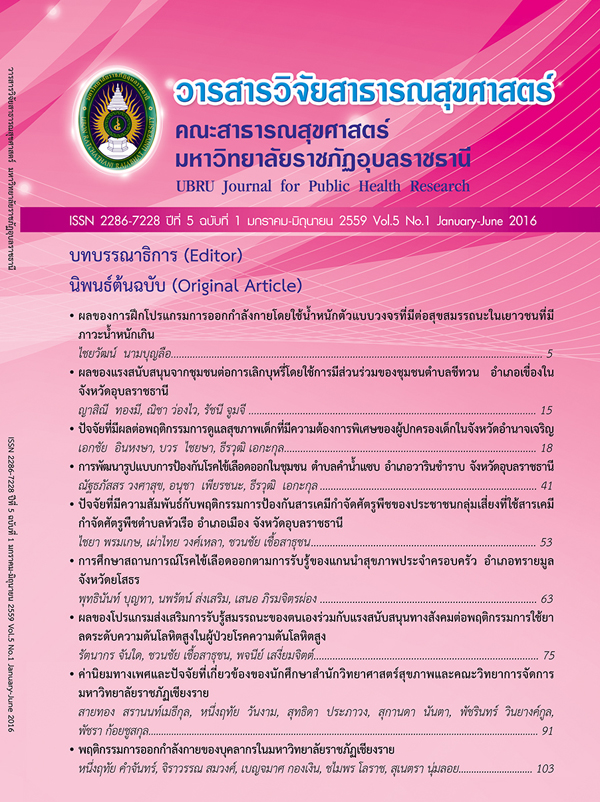Factors Affecting Caring Behaviors of Caregivers to Children with Special Needs in Amnatcharoen Province
Keywords:
Affecting Caring Behaviors, Children with Special NeedsAbstract
The purpose of this research was to study 1) the caring behaviors of children with special needs 2) the factors that affect caring behaviors of children with special needs. 3) building a good Predictive equations caring behaviors of caregivers to children with special needs in Amnatcharoen Province. The total of 192 samples were parents of chil dren with special needs In charge of special education who registered in 2014 in Amnatcharoen Province. The instruments used in research the questionnaire consists of 4 partsas follows : a confidence reliability of 0.95. The data were analyzed using descriptive statistics, frequency, percentage, mean and standard deviation, pearson correlation and multiple regression analysis. The findings of this study revealed : 1. Caring behaviors of caregivers to children with special needs in Amnatcharoen Province was high level. Considering in aspect find that The Prophylaxis was the highest score and subordinate aspect such as Environmental, Health, nutrition, emotional and physical activity, respectively. 2. A good predictors in predicting caring behavior to children with special needs of parents in Amnatcharoen Province had 6 variables were supported by public health officials, the efficacy of health care, received the support of their family members, relationships with children parents, living with parentsand education level : diploma, vocational respectively, All 6 variables were explained avariablesto caring behavior children with special needs of parents in Amnatcharoen Provinceas 73.4 percent. 3. Predictive equations caring behavior to children with special needs of parents in Amnatcharoen Province was written in the form of raw scores and standard scores : Predictive equations in raw scores: Y’ = 4.722+1.732X12+ 1.063X7 +1.090X10 +4.276X5_1 - 3.347X6_1-5.772 X3_4 Predictive equations in standard scores : Z’ = .424Z12+.284Z7+ .19 Z10 + .127Z5_1- .107Z6_1- .101Z3_4
References
จิรวัฒน์ ธนนราพงศ์. (2550). ปัจจัยทางจิตสังคมในการทำนายพฤติกรรมการดูแลเด็กของมารดาที่มีบุตรออทิสติก. วิทยานิพนธ์วิทยาศาสตรมหาบัณฑิต มหาวิทยาลัยเชียงใหม่.
เฉลิม รัตนะโสภา. (2553).ปัจจัยที่มีผลต่อพฤติกรรมการดูแลสุขภาพตนเองของผู้พิการ จังหวัดอำนาจเจริญ. วิทยานิพนธ์สาธารณสุขศาสตรมหาบัณฑิต สาขาวิชาการสร้างเสริมสุขภาพ มหาวิทยาลัยราชภัฏอุบลราชธานี.
ดรุณี มูลคาภา. (2555). ผลการให้บริการช่วยเหลือระยะแรกเริ่มสำหรับเด็กที่มีความบกพร่อง ทางร่างกายหรือการเคลื่อนไหว หรือสุขภาพโดยครอบครัวมีส่วนร่วม. ขอนแก่น : ศูนย์การศึกษาพิเศษ เขตการศึกษา 9 จังหวัดขอนแก่น.
ปริศนา ยิ่งราษฎร์สุข. (2550). พฤติกรรมการดูแลบุตรสมองพิการของมารดาและการสนับสนุนทางสังคมของครอบครัว. วิทยานิพนธ์พยาบาลศาสตรมหาบัณฑิต มหาวิทยาลัยบูรพา.
รุ่งทิพย์ สุจริตธรรม. (2550). ปัจจัยที่เกี่ยวข้องกับพฤติกรรมการดูแลตนเอง ของผู้ป่วยวัณโรคที่มารับการรักษาวัณโรค ณ โรงพยาบาลดอยสะเก็ด จังหวัดเชียงใหม่. เชียงใหม่ : มหาวิทยาลัยเชียงใหม่.
ศรีลักษณ์ หังสสูต. (2551). การฟื้นฟูสมรรถภาพผู้พิการในชุมชน เรื่อง การฝึกผู้ที่มีความผิดปกติเกี่ยวกับการเรียนรู้. กรุงเทพฯ : ศูนย์สิรินธรเพื่อการฟื้นฟูสมรรถภาพทางการแพทย์แห่งชาติ กรมการแพทย์.
ศูนย์การศึกษาพิเศษประจาจังหวัดอำนาจเจริญ. (2556). เอกสารสรุปผลการดาเนินงาน ประจาปีการศึกษา 2556. อำนาจเจริญ : ศูนย์การศึกษาพิเศษประจำจังหวัดอำนาจเจริญ.
สาธารณสุขจังหวัดอำนาจเจริญ, สำนักงาน. (2555). ปัญหาสุขภาพและสุขภาวะผู้พิการ จังหวัดอำนาจเจริญ ปี 2555. อำนาจเจริญ : สานักงานสาธารณสุขจังหวัดอำนาจเจริญ.
สุภาวดี คากุณา. (2550). ประสิทธิผลของโปรแกรมสุขภาพจิตศึกษาต่อพฤติกรรมการดูแลเด็กออทิสติกของผู้ปกครอง ในคลินิกส่งเสริมพัฒนาการโรงพยาบาลพระศรีมหาโพธิ์ จังหวัดอุบลราชธานี. วิทยานิพนธ์สาธารณสุขศาสตร มหาบัณฑิต สาขาวิชาการสร้างเสริมสุขภาพ มหาวิทยาลัยราชภัฏอุบลราชธานี.
อรุณ แสงแก้ว. (2550). พฤติกรรมการดูแลเด็กเล็กของผู้ดูแลในศูนย์พัฒนาเด็กเล็ก. วิทยานิพนธ์ศิลปศาสตรมหาบัณฑิต มหาวิทยาลัยศิลปากร.
Barry, L.C. and others. (2006). “Social Support and Change in Health-Related Quality of Life 6 Months After Coronary Artery Bypass Grafting,” J Psychosom Res. 6 (February) : 185-193.
Carreno, J. and others. (2005). “A Health Promotion Programme in Adventist and Non- Adventist Women Based on Pender’ Model : A Pilot Study,” Public Health. 12 (June) : 346-355.
Cobb Sidney. (1979). “Social Support as a Moderator for life Stress,” Psychometric Medicine. 38 (September – October) : 300-312.
Femke, A Reijenga. (2008). “Disabled Working Life and Welfare State,” Conrad Annual Report. 10 (January) : 34.
Muhlenkamp, A.F. & Sayles, J.A. (1986) “Self – Esteem, Social Support and Positive Health Practices,” Nursing Research. 35, 6 : 334-338.
Murray,R.B. and Zentner, J.P. (1993). Assessment and Health Promotion for the Middle – aged Person : Nursing Assessment and Health Promotion Strategies through the Life Span. 5 thed. London : Appleton and Lange.
Pender. N.J, Murdaugh. C. L. & Parson M. A. (2002). Health Promotion in Nursing Practice. 4thed. New York : Prentice Hall.
Pender.N.J. (1987). Health Promotion in Nursing Practice. 2rded. East Norwalk : Appleton- century-crofts.
Downloads
Published
How to Cite
Issue
Section
License
เนื้อหาและข้อมูลในบทความที่ลงตีพิมพ์ในวารสารวารสารวิจัยสาธารณสุขศาสตร์ มหาวิทยาลัยราชภัฏอุบลราชธานี ถือเป็นข้อคิดเห็นและความรับผิดชอบของผู้เขียนบทความโดยตรงซึ่งกองบรรณาธิการวารสาร ไม่จำเป็นต้องเห็นด้วย หรือร่วมรับผิดชอบใดๆ
บทความ ข้อมูล เนื้อหา รูปภาพ ฯลฯ ที่ได้รับการตีพิมพ์ในวารสารนี้ ถือเป็นลิขสิทธิ์ของวารสารฯ หากบุคคลหรือหน่วยงานใดต้องการนำทั้งหมดหรือส่วนหนึ่งส่วนใดไปเผยแพร่ต่อหรือเพื่อกระทำการใดๆ จะต้องได้รับอนุญาตเป็นลายลักอักษรณ์จากบรรณาธิการวารสารนี้ก่อนเท่านั้น


